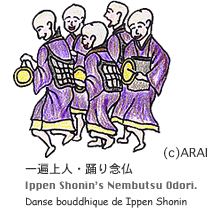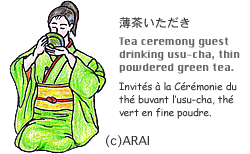|
.
|
 In
the Kamakura Period (1185-1333) when Japan underwent
transition in its political culture from aristocracy-based
to “samurai” (military class)-based with a
consequent change in the people’s sense of values,
causing uncertainty and unease among them, Buddhist monk
Ippen Shonin (1239-1289) appeared to open a new sect of
Buddhism “JI Sect of Pure Land Buddhism”,
preaching “Nembutsu Odori“ (reciting the name of
the Buddha while dancing) for Yuge-zanmai” (pursuing
life of entertainment) with abandonment of everything to
entrust it to the Buddha. This new sect of Buddhism
attracted a large following, producing many people who
withdrew from power and/or abandoned desired for possession
and power, while using their capability for collection of
information throughout the nation in combination with their
unprejudiced minds’ eyes and insights to create new
forms of culture. Such people with title (go)
“Ami” attached to their names joined
“doboshu” attendants to the successive
heads of the new samurai class in the Muromachi period
(1333-1568) known as “shogun”, giving them
political advice and suggestions, while exerting great
influences on the development of the Japanese culture and
art. In
the Kamakura Period (1185-1333) when Japan underwent
transition in its political culture from aristocracy-based
to “samurai” (military class)-based with a
consequent change in the people’s sense of values,
causing uncertainty and unease among them, Buddhist monk
Ippen Shonin (1239-1289) appeared to open a new sect of
Buddhism “JI Sect of Pure Land Buddhism”,
preaching “Nembutsu Odori“ (reciting the name of
the Buddha while dancing) for Yuge-zanmai” (pursuing
life of entertainment) with abandonment of everything to
entrust it to the Buddha. This new sect of Buddhism
attracted a large following, producing many people who
withdrew from power and/or abandoned desired for possession
and power, while using their capability for collection of
information throughout the nation in combination with their
unprejudiced minds’ eyes and insights to create new
forms of culture. Such people with title (go)
“Ami” attached to their names joined
“doboshu” attendants to the successive
heads of the new samurai class in the Muromachi period
(1333-1568) known as “shogun”, giving them
political advice and suggestions, while exerting great
influences on the development of the Japanese culture and
art.
 Among
the prominent “doboshu” with title “Ami”
was “Kan-ami” who is known to have accomplished
“Sarugaku” (literally meaning “monkey
music”, a Japanese traditional form of performing art
that developed into the prototype of Noh play) during the
reign of Ashikaga Yoshimitsu (1368-1394), the third shogun
of the Muromachi shogunate (1338-1573), who erected
Kinkakuji (Temple of the Golden Pavilion) in Kyoto as his
retreat, which was then converted into a temple according to
his last wishes, symbolizing the culture of his period.
Noami (1397-1471) is another typical example of
“doboshu” who played a similarly important role in
the development of the culture during the same period by
attending Ashikaga Yoshimasa (1436-1490), the eighth shogun
of the Muromachi Shogunate (1338-1573), who erected
Ginkakuji (Temple of the Silver Pavilion) as his retreat
that was subsequently turned into a temple in accordance
with his last wishes, the epitome of the culture developed
during his reign. It is interesting to note that Noami,
whose real name was Nakao Saneyoshi, was a vassal of the
Asakura Family, war lords of the Muromachi period
(1333-1568) who established their base in Echizen Province
(now part of Fukui Prefecture where Taikomochi Arai has his
present residence). As an attendant to the Ashikaga shogun,
Noami took charge of managing the works of art and curios in
the shogun’s collection, while contributing to the
development of Suibokuga (ink painting) as the founder of
Ami School and the establishment of the Daisu style
shelf-like furniture for displaying a set of tea ceremony
utensils, having influences on Sen-no-Rikyu (1522-1591), the
founder of the Sen School of Tea Ceremony. Among
the prominent “doboshu” with title “Ami”
was “Kan-ami” who is known to have accomplished
“Sarugaku” (literally meaning “monkey
music”, a Japanese traditional form of performing art
that developed into the prototype of Noh play) during the
reign of Ashikaga Yoshimitsu (1368-1394), the third shogun
of the Muromachi shogunate (1338-1573), who erected
Kinkakuji (Temple of the Golden Pavilion) in Kyoto as his
retreat, which was then converted into a temple according to
his last wishes, symbolizing the culture of his period.
Noami (1397-1471) is another typical example of
“doboshu” who played a similarly important role in
the development of the culture during the same period by
attending Ashikaga Yoshimasa (1436-1490), the eighth shogun
of the Muromachi Shogunate (1338-1573), who erected
Ginkakuji (Temple of the Silver Pavilion) as his retreat
that was subsequently turned into a temple in accordance
with his last wishes, the epitome of the culture developed
during his reign. It is interesting to note that Noami,
whose real name was Nakao Saneyoshi, was a vassal of the
Asakura Family, war lords of the Muromachi period
(1333-1568) who established their base in Echizen Province
(now part of Fukui Prefecture where Taikomochi Arai has his
present residence). As an attendant to the Ashikaga shogun,
Noami took charge of managing the works of art and curios in
the shogun’s collection, while contributing to the
development of Suibokuga (ink painting) as the founder of
Ami School and the establishment of the Daisu style
shelf-like furniture for displaying a set of tea ceremony
utensils, having influences on Sen-no-Rikyu (1522-1591), the
founder of the Sen School of Tea Ceremony.
|
.
|
![]()